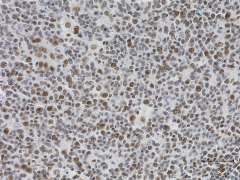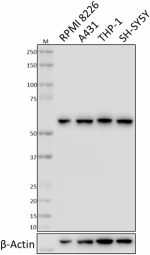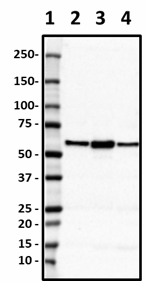- Clone
- 3F3/HDAC2 (See other available formats)
- Regulatory Status
- RUO
- Other Names
- Histone deacetylase 2, YY1-associated factor 1, transcriptional regulator homolog RPD3, YAF1
- Previously
-
Covance Catalog# MMS-5072
- Isotype
- Mouse IgG1, κ
- Ave. Rating
- Submit a Review
- Product Citations
- publications

-

IHC staining of purified anti-HDAC2 antibody (clone 3F3/HDAC2) on formalin-fixed paraffin-embedded human tonsil tissue. Following antigen retrieval using Sodium Citrate H.I.E.R., the tissue was incubated with 5 µg/ml of the primary antibody for 60 minutes at room temperature. BioLegend´s Ultra-Streptavidin (USA) HRP kit (Multi-Species, DAB, Cat. No. 929901) was used for detection followed by hematoxylin counterstaining, according to the protocol provided. The image was captured with a 40X objective. Scale bar: 50 µm -

Total cell lysates (15 µg total protein) from the indicated cells were resolved by 4-12% Bis-Tris gel electrophoresis, transferred to a nitrocellulose membrane, and probed with 1.0 µg/ml (1:500 dilution) of Purified anti-HDAC2 Antibody, clone 3F3/HDAC2, overnight at 4°C. Proteins were visualized by chemiluminescence detection using HRP goat anti-mouse IgG Antibody (Cat. No. 405306) at a 1:3000 dilution. Direct-Blot™ HRP anti-β-Actin Antibody (Cat. No. 664804) was used as a loading control at a 1:10000 dilution (lower). Lane M: Molecular Weight marker. -

Western blot of purified anti-HDAC2 antibody (3F3/HDAC2). Lane 1: Molecular weight marker; Lane 2: 20 µg of Drosophila head lysate. The blot was incubated with 1 µg/mL of the primary antibody overnight at 4°C, followed by incubation with HRP-labeled goat anti-mouse IgG (Cat. No. 405306). Enhanced chemiluminescence was used as the detection system. -

Western blot of purified anti-HDAC2 antibody (clone 3F3/HDAC2). Lane 1: Molecular weight marker; Lane 2: 20 µg of human brain nuclear lysate; Lane 3: 20 µg of mouse brain nuclear lysate; Lane 4: 20 µg of rat brain nuclear lysate. The blot was incubated with 1 µg/mL of the primary antibody overnight at 4°C, followed by incubation with HRP-labeled goat anti-mouse IgG (Cat. No. 405306). Enhanced chemiluminescence was used as the detection system.
| Cat # | Size | Price | Quantity Check Availability | Save | ||
|---|---|---|---|---|---|---|
| 815201 | 100 µL | £189 | ||||
HDAC2 is a member of class I histone deacetylase (HDACs) family, which modulates the chromatin structure by removing acetyl groups (deacetylation) from the side chain of lysine residues on the N-terminal region of core histones (H2A, H2B, H3 and H4). Generally, histone deacetylation gives a tag for epigenetic repression and plays an important role in transcriptional regulation, cell cycle progression and developmental events.
HDAC2 lacks DNA binding activity and executes its function by recruiting transcription factors and forming large transcriptional repressor complexes by associating with MAD, SIN3, YY1 and N-COR. HDAC2 also interacts in the late S-phase of DNA-replication with DNMT1 in transcriptional repressor complex composed of DNMT1, DMAP1, PCNA and CAF1.
In addition to histones, HDAC2 can deacetylate transcription factors and modify their transcriptional activity. HDAC2 has been shown to negatively regulate synaptic plasticity and memory formation. Elevated activity of HDAC2 has been known to associate with the loss of memory and neuronal degeneration.
Product Details
- Verified Reactivity
- Human, Mouse, Rat, Drosophila
- Antibody Type
- Monoclonal
- Host Species
- Mouse
- Immunogen
- This monoclonal antibody was raised against a peptide sequence derived from the C-terminus of the human HDAC2 protein.
- Formulation
- Phosphate-buffered solution.
- Preparation
- The antibody was purified by affinity chromatography.
- Concentration
- 1 mg/mL
- Storage & Handling
- The antibody solution should be stored undiluted between 2°C and 8°C. Please note the storage condition for this antibody has been changed from -20°C to between 2°C and 8°C. You can also check your vial or your CoA to find the most accurate storage condition for this antibody.
- Application
-
IHC-P - Quality tested
WB - Verified - Recommended Usage
-
Each lot of this antibody is quality control tested by formalin-fixed paraffin-embedded immunohistochemical staining. For immunohistochemistry, a concentration range of 5.0 - 10 µg/mL is suggested. For Western blotting, the suggested use of this reagent is 1.0 - 10.0 µg/mL. It is recommended that the reagent be titrated for optimal performance for each application.
- Application Notes
-
Reactivity to Drosophila was only verified by western blot with the purified format.
- Product Citations
-
- RRID
-
AB_2564790 (BioLegend Cat. No. 815201)
Antigen Details
- Structure
- 488 amino acids with a predicted molecular weight of 55.4 kD. It contains a histone deacetylase domain.
- Distribution
-
Widely expressed in many cell types; nucleus.
- Function
- HDAC2 is a histone deacetylase responsible for the deacetylation of ε-amino acid group of lysine residues on the N-terminal tail of core histones (H2A, H2B, H3, H4). HDAC2 forms complex with transcription factors and acts as a transcriptional co-repressor.
- Interaction
- Forms histone deacetylase complexes with HDAC1, RBBP4, and RBBP7. Interacts with GFI1, SNW1, HDAC7, PRDM6, SAP30, SETDB1, SUV39H1, H2AFY, ATR, CBFA2T3, BCL-6, DNMT1, MINT, HDAC10, HCFC1, NRIP1, KDM4A, TSHZ3 and PELP1.
- Biology Area
- Cell Biology, Chromatin Remodeling/Epigenetics, Neuroscience, Transcription Factors
- Antigen References
-
1. Winter M, et al. 2013. EMBO J. 32:3176.
2. Ma P, et al. 2013. PLoS Genet. 9:e1003377.
3. Kurita M, et al. 2012. Nat. Neurosci. 15:1245.
4. Segre CV, et al. 2011. J. Biomed. Biotechnol. 2011:690848.
5. Brunmeir R, et al. 2009. Int. J. Dev. Biol. 53:275.
6. Guan JS, et al. 2009. Nature 459:55. - Gene ID
- 3066 View all products for this Gene ID
- UniProt
- View information about HDAC2 on UniProt.org
Related Pages & Pathways
Pages
Related FAQs
Other Formats
View All HDAC2 Reagents Request Custom Conjugation| Description | Clone | Applications |
|---|---|---|
| Purified anti-HDAC2 | 3F3/HDAC2 | IHC-P,WB |
Compare Data Across All Formats
This data display is provided for general comparisons between formats.
Your actual data may vary due to variations in samples, target cells, instruments and their settings, staining conditions, and other factors.
If you need assistance with selecting the best format contact our expert technical support team.
 Login / Register
Login / Register 
















Follow Us